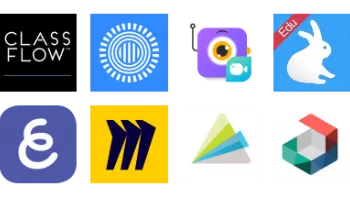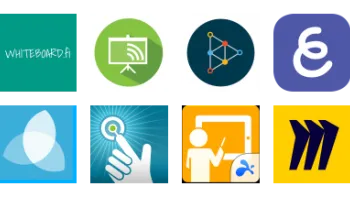Take a look inside 6 images
Doceri Interactive Whiteboard
Pros: iPad mobility means no more being tied to a computer or whiteboard; the record-as-you-go feature helps students track and narrate their thinking.
Cons: Lacks some editing tools, such as a pointer and text tool, which makes it difficult to isolate items or add much detail; no recent updates.
Bottom Line: Teachers and students can spice up presentations and demonstrate processes and problem-solving skills with this well-designed tool.
Doceri's range of backgrounds and the ability to narrate or record presentations offer multiple classroom uses. Social studies teachers may opt to use the map backgrounds to demonstrate population movement or help students learn to identify key geographical features of specific areas. Math teachers can also make good use of the backgrounds, choosing different grids or graphs to teach students about ordered pairs and other geometry concepts. Students can collaborate to work out math equations or record themselves explaining the process they used to arrive at a solution. Other teachers may add their own diagrams or photos as backgrounds and use the tools to label them as they present -- recording them to create material for flipped classrooms or absent students.
Doceri is an interactive whiteboard app where teachers and students can create, record, and narrate slide presentations. Whether they're starting from a blank screen or modifying one of the sample projects, it's a fairly intuitive product. Users may opt to run the app on an iPad alone or while running Doceri Desktop on a computer. When starting a new project, students will see a blank whiteboard with a range of tools at the top. They can choose a background such as a music staff, a map, graph paper, or a plain color, and create a presentation with just a single slide or multiple slides. They can draw a picture, write out some text, or add in some shapes. Students can record motions as they go, or record audio or additional graphics to play over the finished slides. Then, students can save it all and play it back for others to see, or export it as a PDF or YouTube video.
There's no text tool or pointer feature, so teachers may find Doceri to be a bit outdated compared to tools like Explain EDU; however, there's a level of comfort to be found in its simplicity. Also, while the site's blog posts and social media feeds haven't been updated since 2018, scrolling through will provide some inspiration and ideas for classroom use.
Doceri's hands-on design tools and attractive interface can get students' creative juices flowing. With some attention given to basic design principles, students and teachers can create unique presentations to make lessons and projects more engaging. Plus, when teachers run Doceri Desktop alongside the app, it frees them up to move about the classroom and interact with students more easily.
Students can record how they solved a problem or demonstrate how to complete a task through recordings. Giving kids the chance to explain their learning allows teachers opportunities to assess student understanding and provide valuable guidance and feedback. However, they may not want to create a whole presentation that way. All words have to be handwritten using a finger or a stylus, not typed through a font tool; this can make creating longer or text-heavy presentations frustrating. Teachers will need to take some time to teach students about key ideas, details, word economy, and how to incorporate impactful images and graphic organizers into their presentations. The time invested will pay off with more informative slides that rely on the quality of text rather than the quantity.
















